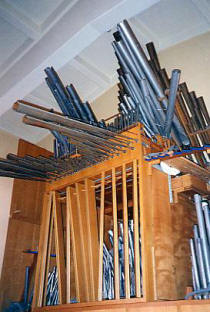St. Francis de Sales Organ
Current Organ, made by Rodgers Instrument Corporation of Hillsboro, Oregon
In 1969, a 25 stop pipe organ, built by the E. F. Walcker & Company of Kleinblittersdorf, Germany, was installed in the gallery at St. Francis de Sales Church in Sherman Oaks. There was a three manual console, the third prepared for future expansion of an Antiphonal organ. The organ builder opted not to use the existing chamber spaces, but to place the instrument in its own case on the back wall between the two large windows. Atop the case was a horizontally mounted copper Spanish Trumpet.
The dedication ceremonies included a Solemn Mass and Blessing of the organ, followed by an organ recital, featuring the well-known Los Angeles based composer, teacher and organist, John Lee. Mr. Lee was organist of St. Vincent's Catholic Church in Los Angeles. The Solemn Mass was accompanied by Lillian L. Galy and Maureen Backus. At this writing, Mrs. Backus continues to serve faithfully as assistant organist.
In 1979, Stephen Park was appointed organist. Over the years, he, with the help of choir members and good friends, like well-known organbuilder and technician Richard F. Muench, expanded the instrument to include the anticipated Antiphonal division and, eventually, a new Choir division. The Antiphonal division was installed behind the reredos in the chancel area, the Choir division utilizing part of the large chamber space on the east side of the gallery. Obviously, it became necessary to expand the console, which originally featured only four general and three divisional pistons. In addition to his fine musical skills, Mr. Park is, by trade, an expert electronic technician. Again, he, with the help of friends, expanded the console to include new lighted drawknob side jambs, new thumb piston rails and a computer combination action system. This system consisted of 2 memory levels, 10 general and 6 divisional pistons. New electronic voices, plus four MIDI channels expanded the organ's tonal resources to 71 stops. The electronic components were built by the Rodgers Organ Company. The MIDI system was custom made to Steve Park's design by Intermidi, Inc. It was programmable and setable in the general organ combination action (on/off) and had 85 general and divisional presets of its own. All parts and labor for this immense project were donated by friends of the church. It was indeed a musical labor of love and was appreciated by all who heard it and witnessed the organ's continuing growth, without cost to the church!
As a result of the January 17, 1994 Northridge earthquake, the St. Francis de Sales Church suffered enormous damage. The organ was torn from its structural support systems, causing it to nearly collapse on itself. Organ experts agreed that it was beyond repair and, and the organ was removed to prevent a further, potentially dangerous collapse of the remaining weighty parts. Several bids for a new organ were submitted, and the contract was eventually awarded to Robert Tall and Associates, Inc., Glendale, California, one of the organ industry's leading firms. Together with Steve Park, Dr. Tall assembled an impressive group of consultants, including Dr. Frederick Swann, director of music and organist at the famed Crystal Cathedral in Garden Grove, California and Mr. Larry Hawkins, an expert in the field of digital research and design.
The new St. Francis de Sales organ was built by the Rodgers Instrument Corporation, Hillsboro, Oregon. Installation and tonal finishing were completed in July, 1995. The best of the surviving pipes and parts from the former organ were incorporated into the new instrument. It is an impressive instrument of 111 speaking stops spread over a handsome four manual console. The pipes are successfully combined with digitally sampled pipe voices, based on Rodgers highly advanced computer networking system, Parallel Digital Imaging technology. It is the largest new instrument of its kind ever built!
A quote from the dedication program notes for the former organ is still as pertinent today as it was in 1969. "An instrument such as this makes it unnecessary to explain why the organ is known as the ‘King of Instruments.’ Is it any wonder that man has seen fit to use this masterpiece of his creative genius to beautify the homage he returns to his creator?"
Original Organ, made by E. F. Walcker & Company of Kleinblittersdorf, Germany
Original Organ Pipes


